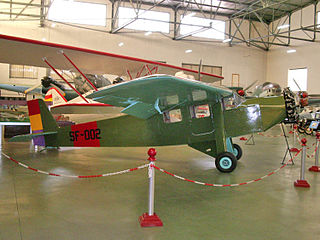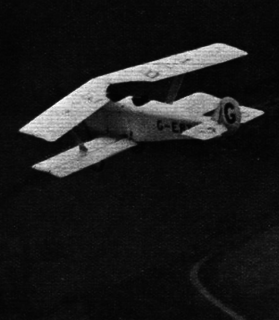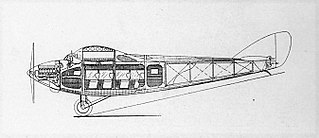Related Research Articles

The Farman F 400 was a 1930s French three-seat cabin high-winged monoplane which was designed and built by Farman.

The Farman F.120 and its derivatives were a family of multi-engine airliners and bombers of the 1920s built by the Farman Aviation Works in France.

The Parnall Imp was an unusual single-engined, two-seat British biplane built in 1927. It had a straight cantilever lower wing which supported the markedly swept upper wing. Only one was built.
The Farman F.480 Alizé was a single engine, two seat, parasol winged monoplane built in France in the mid-1930s. Designed as a tourer and trainer, all Alizés served as training aircraft for government (Republican) forces during the Spanish Civil War.
The Farman F.1010 was a small, low-wing, single-seat monoplane ordered by the French government in 1931 to test in flight a large-calibre cannon. This was mounted between the cylinder banks of an inverted V-8 engine.
The Farman F.420 was a twin engine monoplane, built in France in the mid-1930s to compete in a government contest for an aircraft capable of fulfilling bomber, fighter and reconnaissance roles. Two prototypes were constructed but no production followed.
The Farman F.280 was a three engine, cantilever wing monoplane designed in France as a mail carrier in the early 1930s. Underpowered and slow, only two were built and briefly used.
The Farman F.30A C2 was a two-seat biplane designed as a fighter in France in 1916 and powered by a single, water-cooled radial engine. It showed poor flight characteristics and only one was built, though it was modified twice. It should not be confused with the similarly named Henry Farman HF.30 of 1915, a completely different aircraft which was used in large numbers by the Imperial Russian Air Service.
The Farman F.250 was a small, four passenger single engine low cantilever wing airliner built in France in 1931. The single example built was bought by an airline but was little used, owing to stability issues.

The Farman FF 65 Sport was a French built light biplane, with a single engine and tandem seats, intended for sport and touring. First flown in 1919, it achieved modest sales at home and abroad in the early 1920s. Two unusual modifications produced a biplane glider and a low aspect ratio parasol wing machine.

The Farman F.90 was a single engine biplane transport, carrying 6 passengers. It was built and developed in France in the early 1920s. Though it had some competition successes, it was not put into production
The Bernard H 110 was a single engine, single seat monoplane floatplane fighter designed for a French Navy competition. It flew in 1935 but had only made four test flights when the Bernard company was declared bankrupt, preventing further development.

The SAB DB-80 and SAB DB-81 were single-engine, all-metal French light transports aimed at the air mail market whilst carrying two passengers. Identical apart from their engines, they flew in mid-1930.

The Dewoitine D.430 was a three-engine, high-wing monoplane designed for policing and other roles in France's colonies. It did not go into production.

The Nieuport-Delage NiD 590 was a three engine, high wing monoplane designed for policing and other roles in France's colonies, which did not go into production or enter service.

The Dewoitine D.480 was a French single engine side-by-side sports and training aircraft built in the early 1930s. Two were completed and flew with several different radial engines. One remained active through the 1950s.

The Nieuport-Delage NiD 740 was a French trimotor monoplane designed to carry night mail. Two were built in 1930.
The Morane-Saulnier MS.300 and MS.301 were French parasol wing introductory trainer aircraft, first flown in 1930. They differed only in engine type. Neither reached production but were developed into two similar trainers, the MS.230 and MS.315, which were made in large numbers.

The Nieuport-Delage NiD 540 was a high wing, eight seat, single engine airliner, built in France and first flown in 1930. It did not reach production.
The unsuccessful French Farman F.200 of 1923 shared its type name with the 1929 Farman F.200, the progenitor of a series of parasol wing tourers. It was a two-seat touring aircraft, with a low, thick, cantilever wing. Only one was built and only briefly tested.